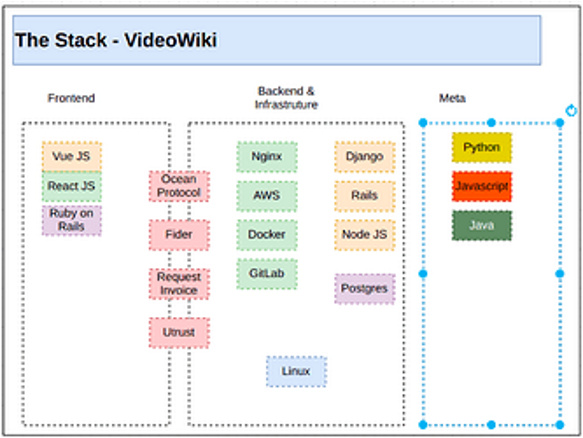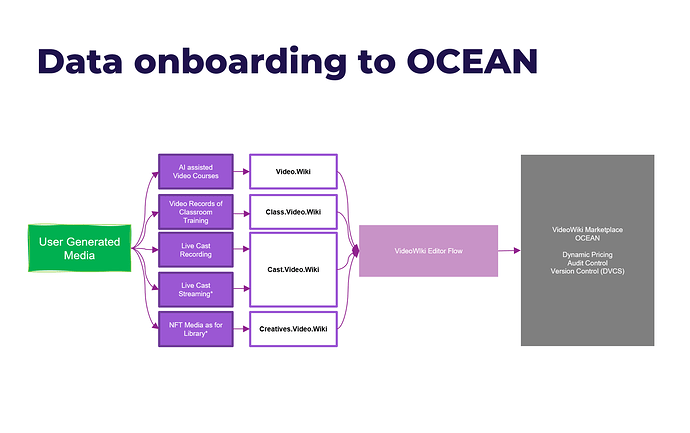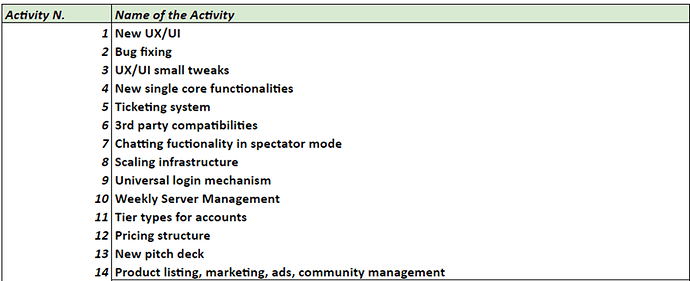Project Name: Creatives.Video.Wiki
Proposal in one sentence: This proposal is to develop a video data union for stock media creatives that will be uploaded by creators to be sold to other educators to include in their videos
Description of the project and what problem is it solving:
VideoWiki CREATIVES as a project brings a decentralized approach to content ownership and sharing. It uses a customized Ocean marketplace to provide educators, researchers (content providers). This current project is scoped to create a data union of video and image stock media which will be annotated in a AI readable format.
As a broader project, VideoWiki is an Open Collaboratory Content Editing Platform that enables rapid Creation, Modification, Protection, and Monetization of Immersive Content.
The content created using our advanced AI models can be published in an IP Protected manner on the blockchain with OCEAN Marketplace. The publisher maintains the IP of the content in form of data tokens which are generated through the OCEAN Protocol.
As an OCEAN community project, it serves as a conduit to add and monetize media content in forms of Videos, Video Streams and Stock Media content.
We are working on structuring a bigger roadmap, where we plug in these data inputs through VideoWiki platform on to the ocean marketplace for the educational sale, purchase and subscriptions to the knowledge content.
Round 13 Deliverables:
- Add a photo/video library that is annotated and enriched with meta data.
- Set a campaign to spread knowledge about data unions and the importance machine readable data sets for creative professionals.
- Get 500 twitter followers
Previous Grant Deliverables:
Round 2: Funded - Content Creation integration and customization to the marketplace. Onboarding the data.
Status - Completed. Live at Video.Wiki (Premium domain purchased and project rebranded)
Round 5: Not Granted - Optimization of the user journey to sign the transactions involved in the OCEAN marketplace listing. Launching the Classroom, and onboarding Class records to Market.
Status - Completed, despite not being funded. Live at Class.Video.Wiki
Round 6: Researched various streaming options to onboard to our marketplace. Build UI around the Casting flow and conducted successful pilot events.
Status - Completed. Private Beta live at CAST.Video.Wiki
Round 10: Not granted
Status - Couldn’t launch Blockchain NFT ticketing
Round 11: Not Granted
Status - Have reached out to ETH SWARM community for support, received partial grant agreement.
We are also writing protocols to bring more utility to the data economy.
Which category best describes your project?
Build / improve applications or integrations to Ocean
Which Fundamental Metric best describes your project?
-
OCEAN Datatoken Consuming Volume. This is (datatoken price in OCEAN) * (no. consumes of that datatoken), summed across all datatokens. It’s the best direct measure of amount of value being created in Ocean Protocol.
Secondary metric: Market WAU -
Number of teams building on Ocean, doing outreach, or unlocking data
What is the final product?
Final product will be a Library of immersive stock media content of educational nature of 5-30 seconds. With suggestion algorithms while other creators (using AI based recommendation), searching library with tags and context. (please see the content creator on videowiki to understand better)
Will be launched at Creatives.Video.Wiki
Funding Requested: $15000
Wallet Address: 0x42a19cd756651A488f1899157c45Af929bf3695F
Project Website: video.Wiki
Current country of residence: Portugal
Contact Email: support@videowiki.pt
Twitter: @Videowiki_pt
Discord:
Category: Build/improve Core Ocean Software
How does this project drive value to the “fundamental metric” (listed above) and the overall Ocean ecosystem? This is best expressed as Expected ROI.
As explained in the data flow diagram above, more streams being added to ramp up the data to marketplace will increase in more data assets on the marketplace. Since our audience and outreach is towards educators and content creators they also bring data buyers to the ecosystem.
Each subsequent stream viz:
- Content Creation (Editor)
- Class records (Class Teleconf)
- Live Casts / Cast Records, with events like private/ticketed (TEDx) and Public (Open streaming as on YouTube)
- Creative Stock Media
etc,
… brings more users to the ecosystem in a web3 application that is well developed and user friendly.
Bang: Adding data to ocean marketplace and minting Data Tokens on Paid assets. About 100 monthly paid Cast splits added to marketplace.
Number of weekly active users in Ocean Market or across All Markets. 1000 Weekly active users inducted on platform with paid listing option.
100 Paid casts with an LTV of $10 per sale (notional minimum value) would give a $1000 trade volume per month.
Increased User adoption will drive a positive feedback loop with new users being invited by current users who will create more paid content and invite others to buy/subscribe to their content. The developed system will run continuously to drive adoption at higher rates driving higher monthly returns.
Buck = $20000
% Success = 80%
Based on previous successes in delivering the projects and initial successful tests, the chances and encouragement to further develop this project is very likely to bring the estimated results. Last grant has given us a fair POC with validations to bring a product to market with a commercial angle. The adoption is still a trickier thing to measure hence we are going with an 80% success probability that the project will get adoption.
ROI = Recurring and expected to add transactional value of $20000 in one year (assuming compounded growth on $1000 initial). Breaking even and continuing to grow in years ahead.
For Ocean community, you can get an access with premium upgrade using this form.
Premium Organizational Account at VideoWiki
Part 2 - Team
Shivam Dhawan
Role: Co-Founder/CTO
Relevant Credentials:
LinedIn: https://www.linkedin.com/in/shivamdhawan/
Background:
BI Consulant and Analytics
Founder at GetBoarded
Web Analytics Manager at Metriplica (now Beablu)
BI Team Lead at Annalect (OMD)
Business Systems Analyst at MetLife
Web Analytics Application Developer & Consultant at Cognizat
Natalia Rheskava
Role: Co-Founder/CIO
Relevant Credentials:
LinkedIn: https://www.linkedin.com/in/nataliia-rzhevska-486a791a8/
Background:
PhD, Grygoriy Scovoroda University in Pereiaslav
Media Relations & International Medical Community (IMC) Lead
HundrED Ambassador
World Economic Forum Digital Member
Claudio
Role: Market Research / Pricing
Relevant Credentials:
LinkedIn: https://www.linkedin.com/in/claudiomatosm/
Background:
Master in Management, Aveiro University
Jyoti Sing
Role: User Experience Designer
Relevant Credentials:
LinkedIn: https://www.linkedin.com/in/jyotising/
Github: https://github.com/jyotising
Background:
User Interface Designer at Pixocrafts
Part 3 - Proposal Details
• Build / improve applications or integration to Ocean, then:
• App will be live, at: https://Cast.Video.Wiki 5
• Here is the OCEAN marketplace data 1 (select Ropsten Test Networks), Here is the platform MarketPlace
• Is your software open-source? Yes
If the project includes software:
• Are there any mockups or designs to date?
(https://Cast.Video.Wiki )) / Planned (Design)
An overview of the technology stack?
VUE, REACT, Python, Django, RoR, WebRTMP, Node.js, AWS components.

Project Deliverables - Roadmap
• Any prior work completed thus far?
• What is the project roadmap? That is: what are key milestones, and the target date for each milestone.
We are working on structuring a bigger roadmap, where we plug in these data inputs through VideoWiki platform on to the ocean marketplace for the educational sale, purchase and subscriptions to the knowledge content.
Why should you vote for our project?
As you understand from our project, we are building data streams to ramp up content on Marketplace (Ocean) and our integrations are running on testnet,
VideoWiki Editor + Class Records + Cast Records + Library Media* + Cast Streams* will use the AI assisted content modification / production which has a paid ramp up to the marketplace.
Project Deliverables - Roadmap
Our most updated Roadmap is presented below to transparently display the different features our team is working in this final development stage of our Cast tool.
We believe that Cast by VideoWiki will be self-sustainable when it’s fully launched, as we believe that our go-to-market strategy is well refined and our predicted market conditions have been effectively stress-tested.
What is the team’s future plans and intentions?
Our Master Plan:
We are building Cast as a tool to further accelerate our growth and adoption of mainstream users to VideoWiki, as we can ramp up educational content on the OCEAN Marketplace . Every tool that we create (Editor, Class, Cast) is a way to outreach key holders of knowledge to create videos, collab with others and upload them as a marketable asset in blockchain, with the use of OCEAN. This is the strategy that we are following, as our mission is to create a culture of knowledge sharing and we do believe Web3 is the technology that will further potentialize this concept.
The path we create with our funnel will continue to lead data assets on a monthly basis and it’s not just a onetime grant ROI. All the stream content will eventually lead to the marketplace in a marketable way.
Additional Information
Our Awards:
- #EUvsVirus Hackathon Challenge Winner
- Hack Back Overall Winner 2020 - UX definitions and first prize
- Semi-finalist of AISolutions 2030 Solving SDG Global Goals through AI
- Winners of Climate KIC Romania
- Winners DigiEduHack by EIT Digital Timisora edition - EUR 1000
Cast by VideoWiki Competitors:
We are mainly competing with big Web2 enterprises like Zoom, WebEx, and Hopin, that sell their services in the B2B space. Their offerings vary according primarily to the number of users registering for events, something that VideoWiki tries to avoid, so you are not punished for having better than expected engagement in your events.
Why we are different? (Unique Selling Proposition):
VideoWiki values meaningful human collaboration, even if it is remotely. This value is cross-functional to our partners and clients, as we offer fully customized support on a 24/7 basis (smoke signals included). We’ve been partnering with projects and companies to build individual specialized features since our platform has launched and we are proud of our way of doing business. We recognize that one of our most cheered feature is the Custom Branding Editor. We offer access to the customization of the event page branding, so the identity of your business will be always present when you are giving your talks (These aspects are something that big companies like Zoom struggle to give away to their clients. We prioritize partnerships rather than transactions/clients).



